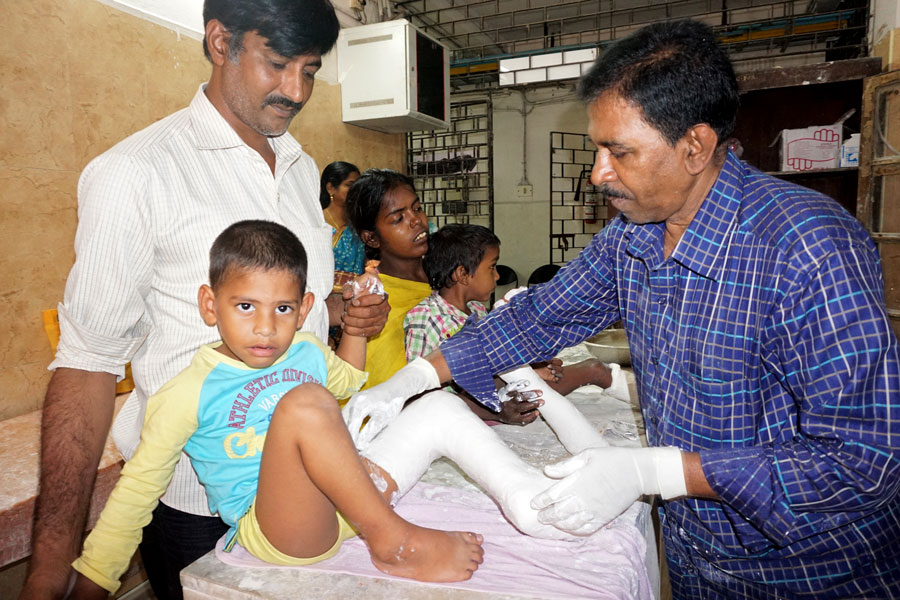Five-month-old Livya Miranda gives a cherubic smile to Younis, the counsellor at the CURE International’s Clinic in the Institute of Child Health (ICH – Government Children’s Hospital in Chennai), as she ties the lace of the tiny Foot Abduction Braces (FAB) on her curved foot. Livya’s mother Lourde Mary has tears in her eyes as her husband Snegan Miranda says, “These people are just great. Thanks to them, our daughter’s foot is slowly straightening.” Outside the consulting room, little Devashri (9 months) wriggles out of her mother’s lap, attempting to walk; the braces do not bother her.


Livya and Devashri are diagnosed with clubfoot and have been referred to the CURE Clinic by their orthopaedicians. They’ve been visiting the clinic since they were a week-old. Clubfoot is a congenital disorder where one or both feet are twisted down and inward, making them look like golf clubs.
CURE International India is a voluntary organisation that provides corrective treatment for this deformity through its 254 designated clinics set up in government hospitals/medical colleges across the country. The organisation trains orthopaedicians to treat patients through ‘Ponseti’ method (see Box) endorsed by WHO, the American Academy of Paediatrics and the Paediatric Orthopaedic Society of India.
While polio can be prevented but cannot be treated, clubfoot cannot be prevented but can be treated. Neglected clubfoot leads to lifetime disability.
Santhosh George G, Director of CURE International, says that of the 30 million births in India every year, over 50,000 children are born with clubfoot. About 38,000 children have enrolled for treatment in the CURE clinics, with an average of 40–50 new children coming in every day.
Back at the ICH, Beulah Vithyakumari, CURE’s State Manager for Tamil Nadu, states that the government supports CURE with space and casting material while the clinic provides counselling for parents, the actual corrective treatment and the special FAB shoes for children. “The shoes are being manufactured at our unit located in Kashmir. The cost varies between Rs 1,000–1,200 depending on the size. We do not charge anything from the patients but if they voluntarily give donations, we accept them,” she says.
Rotary’s role
Rotary is partnering with CURE since last year; it all began in Delhi with the idea mooted by Amar Nath Goyal of RC Delhi South, D 3011, and the club set up a clubfoot clinic at the Safdarjung Hospital. Goyal is the District Clubfoot Committee Chair. Subsequently, RC Delhi Midtown sponsored two clinics — one at St Stephen’s Hospital and another at the Chacha Nehru Bal Chikitsalaya. “We’re connected with St Stephen’s for the last 15 years starting from the polio rehab programme. Dr Mathew Verghese, the HOD of Orthopaedics, is the Technical Director of CURE and he trains doctors all over India in the Ponseti method,” says PDG Raman Bhatia, who is Advisor to the D 3011 Clubfoot Deformity Correction Committee.

Three other clubs — RCs Delhi Rajdhani, Delhi Central and Faridabad NIT — have each sponsored and are in charge of the clubfoot clinics at Kalawati Saran Hospital, AIIMS and BK Hospital, Faridabad.
A Global Grant of $127,000 has recently been approved to take care of these clinics for three years. RC Delhi Midtown is the lead club and Rotary clubs in Belgium led by PDG Emma Groenenn, the international partners. “We want clubs in other Districts too to join hands with CURE and help reach out to more children, as CURE clinics are present in all 29 States,” says Bhatia.
The Delhi clubs help in identifying and referring child patients with clubfoot to these clinics and sponsor their treatment, the cost of which works out to around Rs 10,000 a child. “Most importantly, we highlight the fact that the disorder can be fully corrected if it is treated as early as possible.” Many of the parents are ignorant about the disorder and even mistake clubfoot for polio. While polio can be prevented but cannot be treated, clubfoot cannot be prevented but can be treated. Neglected clubfoot leads to lifetime disability.
“Ideally, treatment must begin as early as even 7–10 days when the child’s bones are soft and flexible. The entire process takes about five years, but once cured, the child can walk as normally as any other person, without any aids or appliances,” he says.
The Ponseti technique
Named after its developer, Spanish orthopaedician Ignacio V Ponseti, the Ponseti technique includes a regimen of manipulation, casts and braces to correct congenital clubfoot disorder, says the State Manager of CURE, Beulah Vithyakumari.
The first phase involves applying a toe-to-groin PoP cast on the leg with clubfoot after gently manipulating the ligaments and tendons. This manipulation is done weekly, to shape the malleable foot, and the plaster cast replaced to retain the degree of correction and soften the ligaments. The process gradually brings the displaced bones to proper alignment. It generally takes about 4–7 casts to achieve maximum foot abduction (correction), after which a percutaneous incision called ‘Tenotomy’ is performed under local anaesthesia on the Achilles tendon through a stab incision. A final cast is applied which remains for 2–3 weeks.
The child should then wear special shoes, the FAB, 23 hours a day for three months and then, for three years, limit its use to overnight and at nap time. The shoes are attached to each other by Denise Brown bar to maintain the shape of the foot.
Poorly conducted manipulations will further complicate the deformity, warns Beulah. Regular follow-up also plays an important role in the correction process. “Otherwise, it will relapse. We have so many such children who undergo the entire process from start again, but as the child grows older, the manipulation process becomes tougher as the bones will not be as supple,” she adds.





